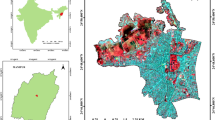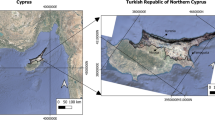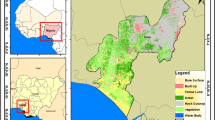Abstract
The South 24 Parganas is the southernmost district of West Bengal. It is characterised by a dynamic condition involving constant adjustments between human livelihood and an extremely vulnerable natural environment. Several stages of land reclamation occurred during the pre-independence period—during successive occupations by the ‘Baroh Bhuniyas’ (the twelve landlords), the Mughals and the British. The process of development here faced several constraints linked to natural, social, cultural, infrastructure and economic factors. This study revolves around the observations that urbanisation precedes environmental stress in the Sundarban due to the drastic impacts of the built-up environment on the natural land character and subsequently the surface conditions. Concretisation in the name of regional development leads to adverse impacts on the local ecosystem. This study aims first to explore the extent of urbanisation in the Sundarbans region of South 24 Parganas District of West Bengal in the last two decades. This phenomenon is then to be related to changes in the land surface temperature (LST) and consequent geo-climatic stresses during the period in question. The paper reveals the rate of changes in land use and related surface temperature transformations within and around both the older settlements and the newly emerged urban areas.
Access this chapter
Tax calculation will be finalised at checkout
Purchases are for personal use only
Similar content being viewed by others
References
Allen A, Lindberg F, Grimmond CSB (2010) Global to city scale urban anthropogenic heat flux: model and variability. Int J Climatol 31. https://doi.org/10.1002/joc.2210
Angel S, Sheppard SC, Civco DL, Buckley R, Chabaeva A, Gitlin L, Kraley A, Parent J, Perlin M (2005) The dynamics of global urban expansion. Project completion report. Transport and Urban Development Department, The World Bank, NY, 200 p
Bagchi E, Chatterjee K (2015) Nature of the process of Urbanization in South 24 Parganas District of West Bengal, India: a spatio-temporal analysis. Arch Appl Sci Res 7(5):73–90
Bhatta B (2009) Analysis of urban growth pattern using remote sensing and GIS: a case study of Kolkata, India. Int J Remote Sens 30(18):4733–4746. https://doi.org/10.1080/01431160802651967
Borthakur M, Nath BK (2012) A study of changing urban lanscape and heat island phenomenon in Guwahati Metropolitan Area. Int J Sci Res Publ 2(11):169–174
Bounoua L, Safia A, Masek J, Lidard CP, Imhoff ML (2009) Impact of urban growth on surface climate: a case study in Oran, Algeria. Am Meteorol Soc. https://doi.org/10.1175/2008jamc2044.1
Grimmond CSB, King TS, Cropley FD, Novak DJ, Souch C (2002) Local-scale fluxes of carbon dioxide in urban environments: methodological challenges and results from Chicago. Environ Pollut 116:S243–S254
Guindon B, Zhang Y, Dillabaugh C (2004) Landsat urban mapping based on a combined spectral-spatial methodology. Remote Sens Environ 92(2):218–232
Lillesand TM, Kiefer RW (2006) Remote sensing and image interpretation, 5th edn. Wiley India Pvt. Ltd., New Delhi, pp 215–329
Mitraka Z, Chrysoulakis N, Doxani G, Del Frate F, Berger M (2015) Urban surface temperature time series estimation at the local scale by spatio-spectral unmixing of satellite observations. Remote Sens 7:4139–4156. https://doi.org/10.3390/rs70404139
Mukherjee S, Joshi PK, Garg RD (2017) Analysis of urban built-up areas and surface urban heat island using downscaled MODIS derived land surface temperature data. Geocarto Int 32(8):900–918. https://doi.org/10.1080/10106049.2016.1222634
Quattrochi DA, Estes MG Jr, Laymon CA, Crosson WL, Howell BF, Luvall JC and Rickman DL (2007) Urban heat islands. In: King MD et al (ed) Our changing planet: the view from Space. Cambridge University Press, Cambridge 298–301
Seto KC, Liu W (2003) Comparing ARTMAP neural network with the maximum-likelihood classifier detecting urban change. Photogramm Eng Remote Sens 69(9):981–990
Sinha P, Verma NK, Ayele E (2016) Urban built-up area extraction and change detection of Adama Municipal area using time-series Landsat images. Int J Adv Remote Sens GIS 5(8):1886–1895. ISSN 2320-0243
Voogt JA, Grimmond CSB (2000) Modeling surface sensible heat flux using surface radiative temperatures in a simple urban area. J Appl Meteorol 39:1679–1699. https://doi.org/10.1175/1520-0450-39.10.1679
Ward D, Phinn RS, Murray TA (2000) Monitoring growth in rapidly urbanizing areas using remotely sensed data. Prof Geogr 52(3):371–386
Yang X (2011) Parameterizing support vector machines for land cover classification. Photogramm Eng Remote Sens 77(1):27–37
Yuan F, Sawaya EK, Loeffelholz CB, Bauer EM (2005) Land cover classification and change analysis of the twin cities (Minnesota) metropolitan area by multitemporal landsat remote sensing. Remote Sens Environ 98(2–3):317–328
Zhang Q, Wang J, Peng X, Gong P, Shi P (2002) Urban built-up land change detection with road density and spectral information from multi-temporal landsat TM data. Int J Remote Sens 23(15):3057–3078
Acknowledgements
The authors are grateful for the advice and supervision of Dr. Lakshminarayan Satpati, Professor, Department of Geography and Director, UGC-Human Resource Development Centre (HRDC), University of Calcutta and Dr. Sumana Bandyopadhay, Professor, Department of Geography, University of Calcutta. We would also like to thank University Grants Commission (UGC) and Council of Scientific and Industrial Research (CSIR) for funding our tenure as research fellows.
Author information
Authors and Affiliations
Corresponding author
Editor information
Editors and Affiliations
Rights and permissions
Copyright information
© 2020 Springer Nature Switzerland AG
About this chapter
Cite this chapter
Haldar, A., Patra, P., Mafizul Haque, S. (2020). Estimation of Surface Thermal Influxes from Satellite Images of the Newly Developed Built-up Areas of South 24 Parganas District, West Bengal. In: Bandyopadhyay, S., Pathak, C., Dentinho, T. (eds) Urbanization and Regional Sustainability in South Asia. Contemporary South Asian Studies. Springer, Cham. https://doi.org/10.1007/978-3-030-23796-7_6
Download citation
DOI: https://doi.org/10.1007/978-3-030-23796-7_6
Published:
Publisher Name: Springer, Cham
Print ISBN: 978-3-030-23795-0
Online ISBN: 978-3-030-23796-7
eBook Packages: Political Science and International StudiesPolitical Science and International Studies (R0)




